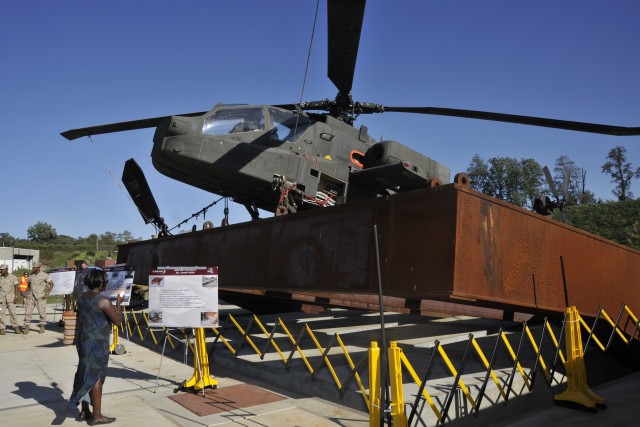
tilt-table for later live-fire and other tests and evaluations. The new RSAF facility tests U.S. military an... VIEW ORIGINAL
The Army Research Laboratory unveiled its latest efforts in ensuring the military's aircraft are safe and effective on the battlefield during a ribbon-cutting ceremony Sept. 8.
The ARL Rotorcraft Survivability and Assessment Facility will give the Department of Defense accurate and timely test and evaluation information that could lead to improvements in aircraft design and reduce injury and death, said John Miller, ARL director.
The state-of-the-art facility will "address an immediate need for evaluation and assessment," said Miller, by testing "all the kinds of threats that our Soldiers and warfighters in theater have to deal with."
The RSAF provides a full spectrum of aircraft survivability assessment services, including support to advanced system developments, quick responses to new threats, and liveA,A!-fire testing and experimentation.
Costing about $12 million, the facility construction began in October 2007 and was completed in July with the first helicopter, an AH-64D Apache Longbow Block III attack helicopter, arriving in late August.
The Apache Block III will be the first system tested at the RSAF. The Block III is an upgrade that will allow pilots the ability to view real-time unmanned aircraft systems feeds in the cockpit, among other network and multi-role weapon system improvements, according to Army statements.
The upgrade is expected to be applied to all Apaches, but they must be fully evaluated on how they will hold up in war before they're fielded.
"When the Army upgrades something (or acquires a new system), it's mandated by law that it undergoes realistic ballistic vulnerability testing," said Fred Marsh, RSAF team leader. "That's what we do for aircraft."
Co-located with ARL's Airbase Experimental Facilities 6 and 7, which execute about 20 evaluation projects a year, the RSAF will add additional investigative resources to improve helicopter and warfighter survivability for the Army and the DoD.
"It overall provides us with an additional advanced test site," said Marsh. "That's a significant improvement to our mission in itself."
Not only does it bring additional capabilities, it also brings new ones. The site is equipped with a tilt-table system that allows the test engineers to fire at the helicopter at multiple angles, including from below - something that couldn't be easily done before.
"The ability to maneuver the target gives us a lot more opportunity to position (the aircraft) at previously unachievable elevations, significantly expanding our test capabilities," said Marsh.
It's also equipped with standard and high-speed video camera systems that will supplement more than 400 other points of data collection to include temperature, blast pressure, strain and stress. Small arms, anti-aircraft artillery, high-explosive warheads and several non-conventional munitions are just some of the live-fire testing capabilities.
The critical information gathered from the live-fire tests is mostly used by program managers, the Army Evaluation Center, other DoD decision makers as well as being used to support mathematical modeling and analysis along.
And sometimes real-time assessments are also needed, said Marsh. Recently an aircraft was believed to be shot down by enemy fire in Afghanistan, and to understand what happened, the Army and Air Force turned to Marsh and his team to recreate the scenario.
Whether the information is used in models or to recreate a battlefield scene, Marsh said, he knows who he ultimately is working for.
"This all directly supports the warfighter," said Marsh.

Social Sharing